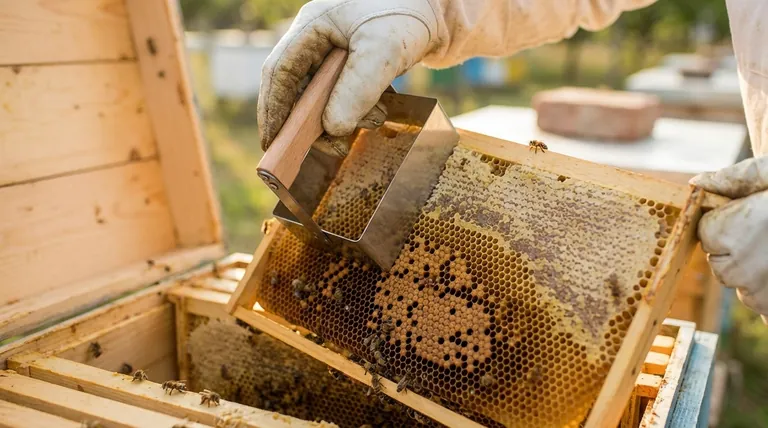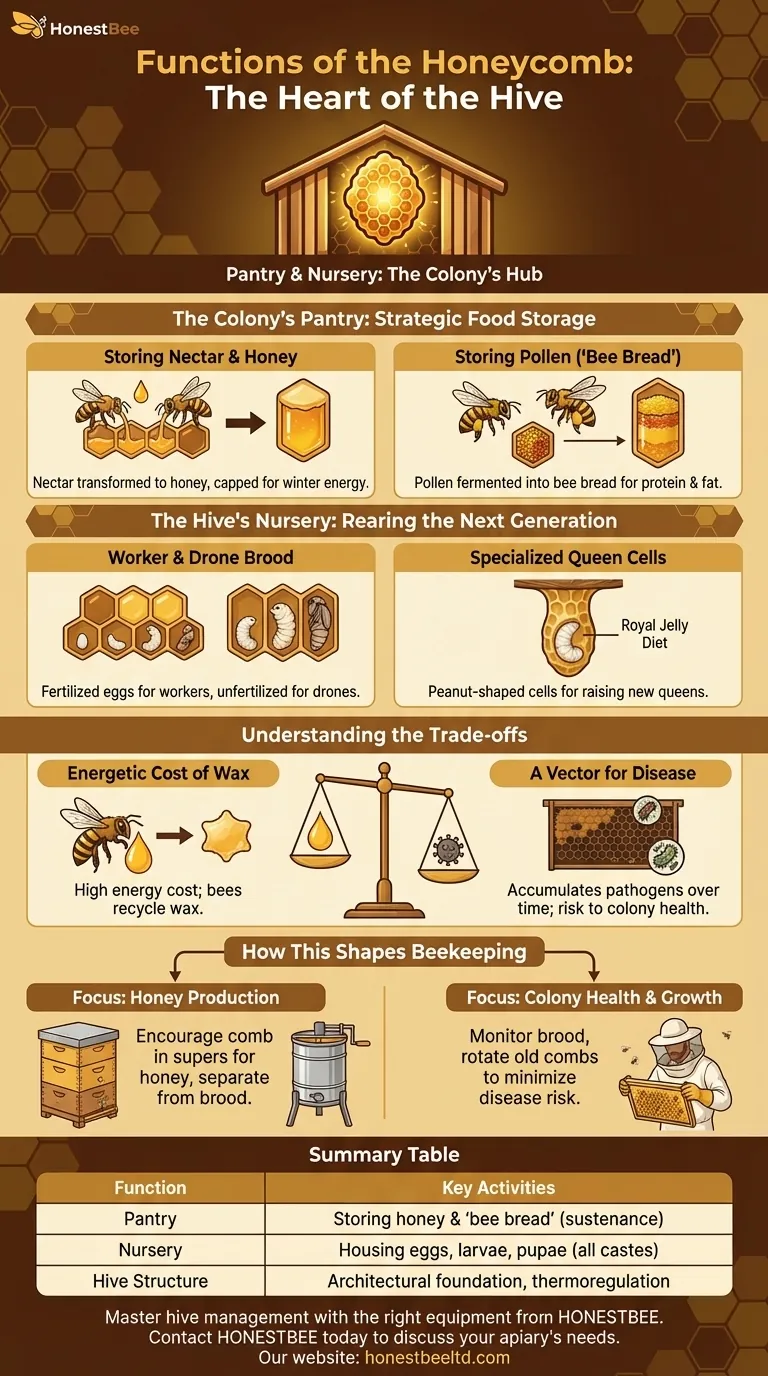In essence, the honeycomb is the bee colony's combined pantry and nursery. This intricate beeswax structure serves as the central hub for all vital colony activities. It is built primarily for two purposes: storing all food resources and housing the next generation of bees from egg to adult.
The comb isn't just a passive structure; it is the very heart of the hive. Its dual-purpose design for food storage and brood rearing is the architectural key that enables a colony's survival, growth, and long-term success.

The Colony's Pantry: Strategic Food Storage
The most immediate function of the comb is to serve as the colony's larder. The bees organize their food stores with remarkable efficiency, creating a buffer against scarcity.
Storing Nectar and Honey
Worker bees deposit collected nectar into comb cells. They then transform it into honey through dehydration and enzymatic processes, capping the finished cell with wax for long-term preservation. This honey is the colony's primary carbohydrate source, vital for surviving winter.
Storing Pollen ("Bee Bread")
Pollen is the bees' source of protein and fats, essential for raising young. Foragers pack pollen into cells, mix it with a small amount of nectar, and allow it to ferment slightly, creating what is known as "bee bread."
The Hive's Nursery: Rearing the Next Generation
The second critical function of the comb is to house the colony's brood—the eggs, larvae, and pupae. This area is typically located in the central, warmest part of the hive.
Housing Worker and Drone Brood
The vast majority of the comb consists of standard-sized hexagonal cells used by the queen to lay fertilized eggs, which develop into female worker bees. The queen will also lay unfertilized eggs in slightly larger cells, which develop into male drones.
Specialized Cells for Royalty
When the colony needs a new queen, workers build special, downward-facing, peanut-shaped cells. A larva placed in one of these "queen cups" and fed a special diet of royal jelly will develop into a queen.
Understanding the Trade-offs
While the comb is a marvel of engineering, its design and material come with inherent challenges that a colony must manage.
The Energetic Cost of Wax
Producing beeswax is an extremely energy-intensive process for bees. They must consume large quantities of honey to secrete tiny flakes of wax. This high cost is why bees are masterful recyclers of wax and why the hexagonal shape—which uses the least amount of material for the most storage—is so crucial.
A Vector for Disease
Because the comb is used repeatedly for brood rearing and food storage, it can accumulate pathogens, pesticides, and toxins over time. Old, dark comb can become a reservoir for diseases that threaten the health of the entire colony.
How This Understanding Shapes Beekeeping
Recognizing the comb's dual functions is fundamental to successful hive management. Your approach should align with your specific goals for the colony.
- If your primary focus is honey production: Your goal is to encourage bees to build comb for honey storage in designated boxes (supers), keeping it separate from the brood nest.
- If your primary focus is colony health and growth: Your priority is to monitor the brood comb for healthy patterns and systematically rotate out old combs to minimize the risk of disease.
By recognizing the comb as the functional heart of the hive, you gain a fundamental understanding of the colony's health, priorities, and needs.
Summary Table:
| Function | Key Activities |
|---|---|
| Pantry (Food Storage) | Storing honey and 'bee bread' (pollen) for colony sustenance. |
| Nursery (Brood Rearing) | Housing eggs, larvae, and pupae of worker bees, drones, and queens. |
| Hive Structure | Provides the architectural foundation for all colony activities and thermoregulation. |
Master hive management with the right equipment from HONESTBEE.
Understanding the comb's critical role is the first step; managing it effectively requires durable, well-designed beekeeping supplies. Whether your focus is maximizing honey production or ensuring strong colony health, HONESTBEE supplies commercial apiaries and beekeeping equipment distributors with the wholesale-focused tools needed for success.
Contact HONESTBEE today to discuss your apiary's needs and discover how our equipment supports robust comb building and overall hive vitality.
Visual Guide

Related Products
- Heavy Duty Stainless Steel Honeycomb Cutter
- Wooden Bee Brush with Triple Row Artificial Fiber for Beekeeping
- Wooden Bee Brush with Double-Row Horsehair Bristles
- Electric Honey Press Machine for Squeezing Honey Comb Press Equipment
- Electric Flatting and Embossing Machine with Tray for Beekeeping
People Also Ask
- What are the features of a stainless steel honey uncapping knife? Unlock a Cleaner, More Efficient Harvest
- What is the basic principle of the honey extractor? Harness Centrifugal Force for Efficient Harvesting
- What equipment do you need to make honey? A Complete Guide to Starting Your Apiary
- When can new beekeepers expect to harvest honey? A Guide to Your First Successful Harvest
- What type of honey extractor is best? Maximize Your Harvest Efficiency with the Right Choice



















